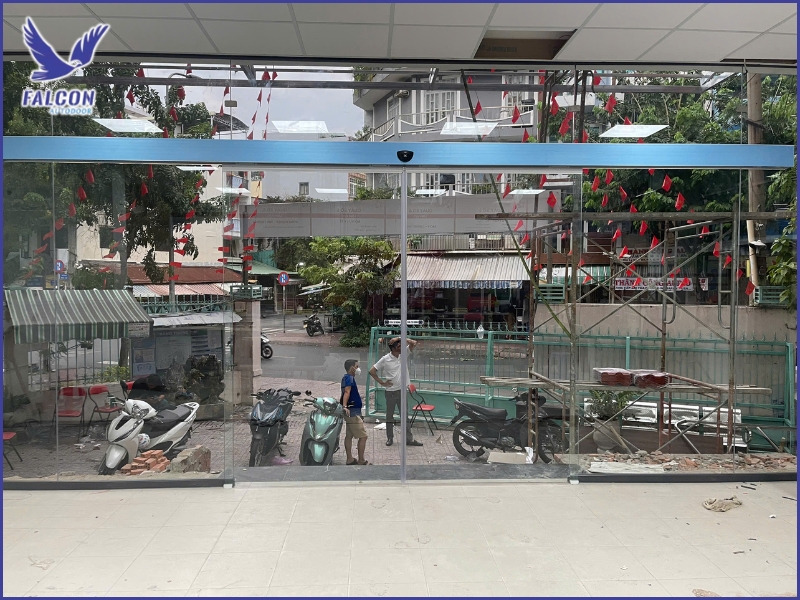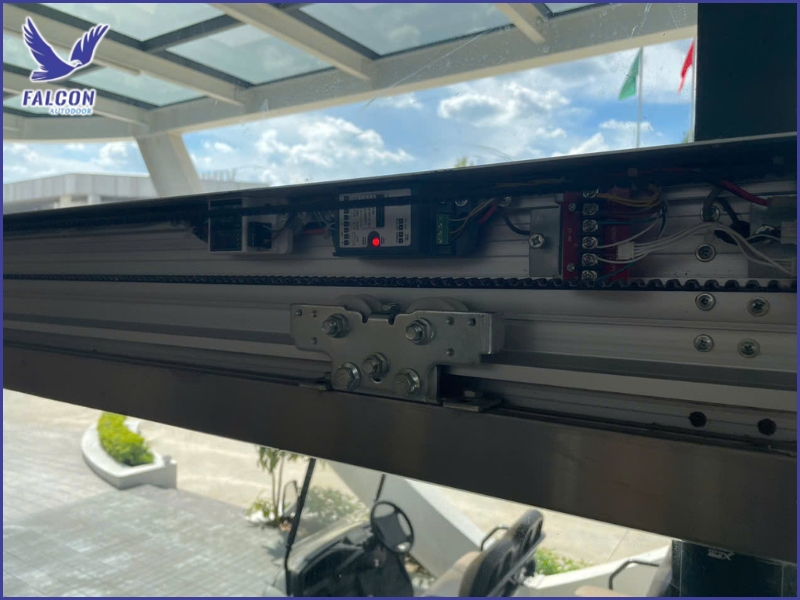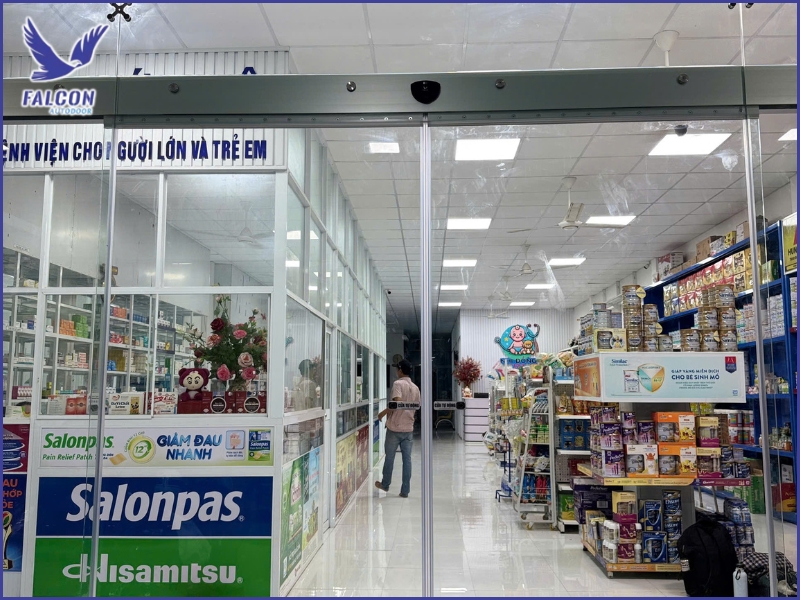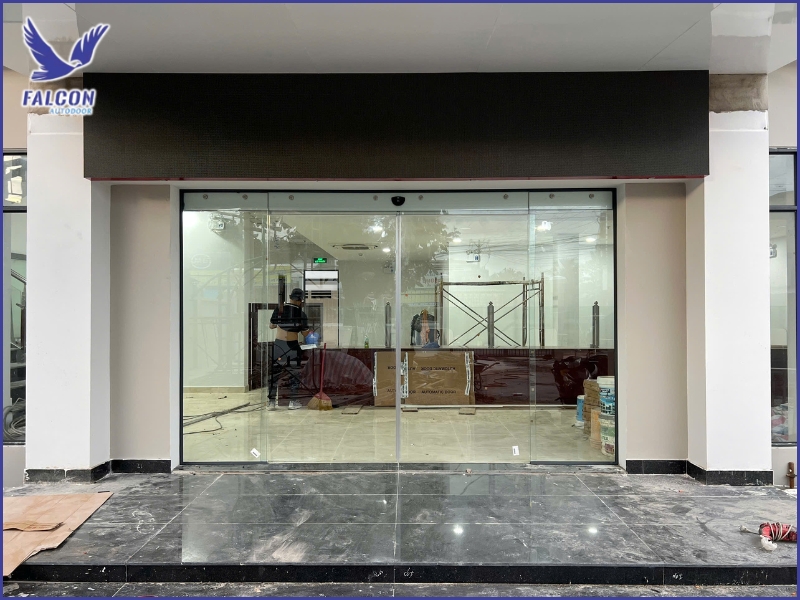Do automatic doors use much electricity? An operating cost analysis
Automatic doors bring convenience and a modern look to any space, yet many people worry about electricity consumption over time. Drawing on experience from hundreds of installations, Thuy Linh Long breaks down operating costs below to show that automatic doors are efficient and durable in real-world use.
1. How do automatic doors consume electricity?
Automatic doors do not continuously draw power as many assume. Electricity is only consumed when the motor activates to open or close the door, or when sensors detect movement. In standby mode, energy use is extremely low, meaning the overall daily consumption remains minimal.
1.1 How the motor operates
The door’s motor runs only for a few seconds during each open-close cycle after receiving a signal from motion or safety sensors. Once the movement stops, it returns to low-power standby. This short activity period keeps energy usage significantly lower than most electrical equipment used in a building.
1.2 Typical power consumption
Most automatic door motors range between 60 W and 150 W depending on size and model. Each complete cycle consumes only a few watt-hours, far less than a household appliance. Even with hundreds of daily operations, total electricity use is comparable to running a single LED bulb continuously.
1.3 Real-world performance
During normal operation, the door remains idle most of the time and therefore consumes almost no electricity. This results in very low monthly utility costs often less than 1% of the total power usage of a home or business facility, much lower than HVAC or lighting systems.

2. Factors influencing electricity consumption
The power consumption of an automatic door depends on several factors such as door type, size, usage frequency, motor quality, and environment. Understanding these factors helps you choose the right system that ensures both performance and energy savings.
2.1 Door type and mechanism
Sliding and swing doors are the most energy-efficient because their mechanisms are simple and lightweight. Revolving or curved sliding doors, commonly found in hotels or malls, require larger motors and multiple sensors, thus using slightly more electricity to maintain smooth and safe rotation.
2.2 Door size and weight
Larger and heavier leaves demand higher-capacity motors to generate sufficient torque. This naturally increases electricity use per cycle. Conversely, compact or lightweight glass doors consume much less energy and place less strain on the motor, improving long-term efficiency.
2.3 Frequency of daily use
Doors installed in high-traffic areas such as hospitals or supermarkets open and close thousands of times daily, which raises total consumption. Residential doors, on the other hand, operate only a few hundred cycles per day, keeping power usage extremely low over time.
2.4 Motor quality and accessories
High-quality motors and synchronized accessories are optimized for low energy draw and smooth operation. Poor-quality or mismatched parts generate friction, vibration, and heat loss, which increases electricity usage and shortens the system’s service life considerably.
2.5 Installation environment
External factors such as humidity, heat, and dust accumulation can force the motor to work harder. A clean, dry environment reduces mechanical resistance, helps maintain normal operating current, and significantly cuts unnecessary energy waste throughout the year.

3. Operating cost analysis in real conditions
Despite concerns about electricity consumption, the operating cost of automatic doors remains very small compared to other systems. Calculating usage based on average cycles per day proves that these doors are extremely economical in both homes and commercial facilities.
3.1 Residential cost estimates
For a home door using a 60 W motor with about 200 cycles per day, the total power use averages 0.1-0.2 kWh daily. That equals roughly VND 20,000-40,000 per month, a negligible amount in household electricity bills but delivering clear convenience and comfort.
3.2 Commercial cost examples
A retail or hospital entrance operating 800-1,000 cycles daily with a 90 W motor consumes around 0.8-1.2 kWh per day. Monthly electricity costs range between VND 200,000-300,000, still far lower than the power needed for air-conditioning or continuous lighting.
3.3 Comparison with other electrical systems
An air-conditioner rated at 1 HP typically uses 0.8-1 kWh per hour. In comparison, a door’s total daily energy consumption often equals less than one hour of AC operation. This shows that automatic doors are far from being a major electricity expense.
3.4 Overall assessment
No matter the building type, electricity for door operation accounts for only a minor fraction of total expenses. Because of this efficiency, automatic doors are widely installed in both residential and commercial projects seeking convenience, style, and cost control.

4. Ways to save energy and improve performance
Although automatic doors consume little power, there are several effective ways to further enhance energy efficiency. These practices also extend equipment life, maintain stability, and ensure safe operation in every environment.
4.1 Choose a motor with proper capacity
Select a motor that matches the door’s weight and usage level. An undersized motor overheats and wastes energy, while an oversized one consumes unnecessary power. The correct capacity ensures optimal torque, quiet movement, and minimal electricity loss.
4.2 Install precise, high-sensitivity sensors
Accurate sensors detect movement only when necessary, preventing repetitive or false activations. By reducing the number of unnecessary cycles, you can lower total energy use and mechanical wear while keeping smooth access for all users.
4.3 Schedule regular maintenance
Periodic cleaning of tracks, recalibrating motion speed, and checking electrical components help reduce friction and resistance. A well-maintained door requires less effort from the motor, resulting in lower power draw and fewer service interruptions.
4.4 Utilize energy-saving and backup modes
Many Falcon models feature standby energy-saving functions that automatically reduce idle power. Adding an uninterruptible power supply (UPS) keeps doors functional during outages while stabilizing voltage and protecting the controller from surges.

5. Thuy Linh Long - Energy-efficient Falcon automatic door solutions
Choosing the right supplier is key to combining convenience with sustainable energy use. Thuy Linh Long provides genuine Falcon automatic doors designed with energy-saving motors, smart sensors, and comprehensive professional support for every project.
Advantages of working with Thuy Linh Long:
-
Genuine Falcon products optimized for low-power consumption and durability.
-
Expert consultation to select the most efficient system for your building type.
-
Professional installation and maintenance ensuring quiet, stable operation.
-
Transparent pricing and exclusive offers for new customers.

If you’re looking for a modern, durable, and energy-efficient automatic door solution, contact Thuy Linh Long today for a free consultation, on-site evaluation, and a detailed quotation tailored to your project’s needs.
THUY LINH LONG SERVICES TRADING COMPANY LIMITED
DISTRIBUTOR
Address: 243D Vuon Lai Street, Phu Tho Hoa Ward, Tan Phu District,
Ho Chi Minh City, Vietnam.
Tel: +84 28 22497999
E-mail: cuatudong24h@gmail.com
SUPPLIER
KUM YANG MATERIALS CO.,LTD
Address: 124-60, Myeongdong-ro, Hallim-myeon,
Gimhae-si, Gyeongsangnam-do, 50851, Korea.
Tel: 82-55-345-8380










